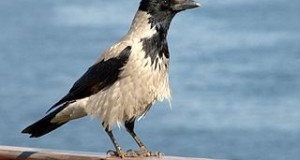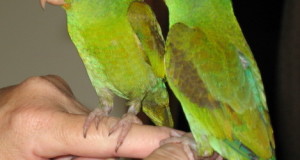“Cockatoo”? Yes, molecular genetic studies have revealed that this most common of pet birds is actually a true cockatoo. Today I would like to pass along a few facts about its life in the wild.
Range
 Cockatiels range throughout nearly all of interior Australia and along the northwestern coast. During drought years, immense flocks may appear in coastal areas from which they have been absent for decades.
Cockatiels range throughout nearly all of interior Australia and along the northwestern coast. During drought years, immense flocks may appear in coastal areas from which they have been absent for decades.
Food and Feeding
Unlike most parrots and cockatoos, cockatiels are clad in subtle gray – perhaps to camouflage the birds as they feed on the ground. They also feed in trees and bushes, and have been observed consuming mistletoe berries – a toxic meal that would kill most other bird species. Cockatiels sometimes forage in mixed species groups, especially with red-rumped parrots (Psephotus haematonotus).
Reproduction
In common with the hardy budgerigar, cockatiel reproduction is driven largely by rainfall. The usual breeding season extends from August to December, but they may nest as early as April if conditions are favorable. The ability to come into breeding condition on “short notice” may account for the egg-laying success (sometimes “over success!) of pet cockatiels and budgerigars. In captivity conditions are always good (hopefully!) and the birds take maximum advantage of this happy situation.
The Australian Avicultural Society has posted an informative article on cockatiel natural history at:
http://www.birds.org.au/cgi-bin/articles.pl?Cockatiel
 That Bird Blog – Bird Care and History for Pet Birds
That Bird Blog – Bird Care and History for Pet Birds



hello there! i’m doing a research paper on the history of cockatiels, and i cant find out WHEN this bird was domesticated! if you have any idea, could you please share it with me?
Hello shannell,
Unfortunately, Frank is out having emergency surgery right now, but should be back before the end of the week. At this time, he’ll answer your cockatiel question. Sorry for the delay.
Hello Shannell, Frank Indiviglio here. Thanks for your interest in our blog. I apologize for the long delay in responding to you…an emergency surgery put me out of commission for a time.
The best reference on the subject, Forshaw’s Parrots of the World, is strangely silent on the matter.
As you likely know, the bird was first officially described by Robert Kerr in 1792. Most general care references state that it was taken into captivity “soon after this”. This would be in line with the case histories of other popularly kept Australian parrots…once “discovered” by a European (Kerr hailed from Scotland), they were taken into captivity.
I found an undocumented reference that they were first exported to Europe (France) in the mid-1850’s. The only documentation I could find re early captive breeding supports this contention:
The Field (June 22, 1872) – breeding in Europe in 1872.
Nests and Eggs of Australian Birds (A J Campbell, 1900) – breeding in Europe, approximately 1898.
Sorry I could not be of more help.
Good luck and please keep me posted.
Best regards, Frank Indiviglio.
Do cockatiels denude trees in the wild? When I give my birds branches to chew on, they go about plucking each leaf off the branch
Hello Kate, Frank Indiviglio here.
Thanks for your interest in our blog.
Cockatiels and other parrots are constantly pulling leaves, stripping bark and exploring for food in the wild. They may do this more in captivity as so little of their time is spent foraging for food. Providing them with tree limbs and foraging toys is very beneficial for their health and well being; parrots are very intelligent, curious birds and decline rapidly if allowed to become bored in captivity.
Good luck and please keep me posted.
Best regards, Frank Indiviglio.
hi um i have to of these birds and they have been ating but they never laid an egg.and the female birld doesn’t have any feathers on her neck because the male keeps on taking them off. is that mating?
Hello Alexandra, Frank Indiviglio here.
Thanks for your interest in our blog.
The female may be too young to reproduce, or perhaps either she or the male is infertile. Be sure to check that she is not egg-bound; this would be evidenced by straining, lethargy and, sometimes, a swollen area around her vent.
Unfortunately, male cockatiels can become overly-aggressive when mating, especially when kept with the female in an average-sized cage. You’ll need to separate them, as eventually the stress as well as skin injuries will cause the female to become severely ill. You can try to re-introduce them after a time, but not before she has re-grown her feathers.
Good luck and please keep me posted.
Best regards, Frank Indiviglio.